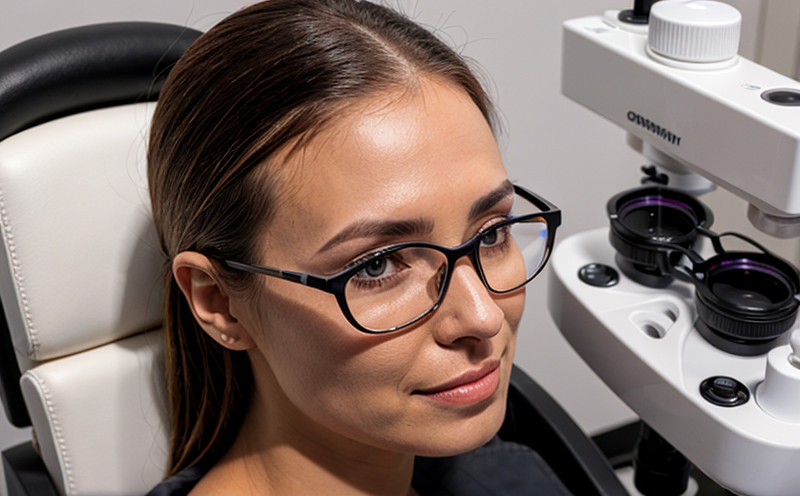USP Ophthalmic Gel Rheological Profile Testing
The USP (United States Pharmacopeia) ophthalmic gel rheological profile testing is a critical procedure used to ensure the quality and safety of pharmaceutical products intended for ocular use. This service plays an essential role in confirming that gels meet specific physical characteristics as outlined by the United States Pharmacopeial Convention.
The rheological properties of ophthalmic gels are vital because they influence how easily the gel can be applied, how well it adheres to the eye surface, and its overall performance. The rheological profile refers to a comprehensive set of physical characteristics that describe the behavior of a material when subjected to external forces or shearing stress.
For ophthalmic gels, this includes viscosity, elasticity, and plasticity. These properties are influenced by multiple factors such as temperature, concentration of active ingredients, and excipients. The rheological profile is tested under various conditions to ensure that the gel maintains its intended form and function throughout its shelf life.
The testing process involves several steps to ensure comprehensive evaluation:
- Sample Preparation: Samples are prepared according to USP guidelines, ensuring they represent the actual product in terms of composition and formulation.
- Rheological Analysis: Using advanced rheometers, samples are subjected to controlled shear stress over a range of temperatures. The response of the gel is recorded, providing insights into its viscosity as a function of temperature and shear rate.
- Viscosity Measurements: Viscosity is measured using both rotational and oscillatory methods. Rotational tests provide data on the dynamic viscosity, while oscillatory tests give insight into the elasticity and plasticity through complex modulus measurements.
The rheological profile testing process is not only about measuring physical properties but also understanding their implications for patient safety and efficacy. For instance, a gel that becomes too viscous at higher temperatures might be difficult to apply comfortably by the user. Conversely, if it is too fluid, it may not adhere well to the eye surface.
Compliance with USP standards ensures that pharmaceutical products are safe and effective for their intended use. This testing method helps in identifying any deviations from expected behavior that could impact product performance or safety. The results of these tests are critical for quality control, ensuring consistency across batches and compliance with regulatory requirements.
Furthermore, rheological profile testing plays a crucial role in the development phase of ophthalmic gels. R&D engineers use this data to fine-tune formulations, optimizing properties such as spreadability and retention on the eye. This optimization can lead to improved patient comfort and better therapeutic outcomes.
Industry Applications
The USP ophthalmic gel rheological profile testing is widely applicable across various segments of the pharmaceutical industry, particularly in the development and quality control of ocular gels. These applications span from the early stages of product development to final batch release.
In the research and development (R&D) phase, rheological testing helps in formulating new products by providing insights into how different ingredients interact under various conditions. This data is crucial for optimizing formulations to meet specific therapeutic needs while ensuring patient comfort.
During manufacturing, this test ensures that each batch of gel produced meets the required specifications. Variations in temperature or processing can affect rheological properties significantly, and consistent results across batches are essential for quality assurance.
The final phase of application is during the release testing of products intended for commercial sale. Compliance with USP standards guarantees that the product is safe for use by consumers, which is critical for maintaining public trust in pharmaceutical companies.
Eurolab Advantages
EuroLab is dedicated to providing top-tier rheological profile testing services specifically tailored for ophthalmic gels. Our team of experts ensures that every test meets the highest standards, leveraging state-of-the-art equipment and methodologies.
We employ advanced rheometers capable of precise measurements over a wide range of temperatures and shear rates. This allows us to capture detailed rheological profiles, providing comprehensive data for our clients.
Our commitment to accuracy is further enhanced by rigorous quality control procedures. Every sample undergoes multiple checks to ensure consistency in testing conditions and results. This approach guarantees that the final reports are reliable and actionable.
EuroLab's expertise extends beyond just executing tests; we also offer consultative services to help our clients understand the implications of their test results. Our team can guide you through interpreting rheological data, helping you make informed decisions about product development and quality control.
Environmental and Sustainability Contributions
EuroLab's commitment to environmental sustainability is reflected in our approach to testing services. By ensuring that products meet stringent USP standards, we contribute to the overall health of consumers who use these products.
The accurate assessment of rheological properties ensures that ocular gels are safe and effective, reducing the risk of adverse effects on patients. This not only enhances patient safety but also minimizes waste from ineffective or unsafe products reaching the market.
By providing precise data for product optimization, we help our clients reduce unnecessary iterations in development cycles. Efficient formulations can lead to lower production costs and reduced resource consumption during manufacturing processes.





